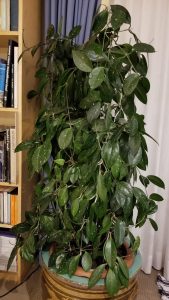
I live in TORONTO.
What should I do to make this plant flower. It is quite large with healthy dark green leaves about 12 years old. It is next to a large south facing window, lots of light but only once in all this time did it get 3 blooms. I don’t water it a lot and often let the soil dry out completely.
Hmm. Here are some thoughts on how you might help your Hoya to bloom.
Wax or Hoya plants (Hoya spp.) produce umbels of small, waxy-looking, star-shaped flowers which are often quite fragrant. An umbel is a rounded cluster of flowers. The flowers can be pink, white, purple, brown or even red, depending on the species and cultivar. They do not bloom easily, however. The plants must be at least a few years old before they bloom, and generally need at least one stem to be three feet long. However, getting your Hoya plant to bloom is possible, so long as you care for the plant in the right conditions.
Place your Hoya near a window. Sufficient light is one of the most important contributing factors when trying to get a Hoya to bloom. The ideal location indoors is right in front of a window facing east or west where it is exposed to two to four hours of direct sunlight. Your plant should also be exposed to bright, indirect light during the rest of the day.
Hang sheer curtains if you place your plant in front of a south-facing window. It can also be placed in front of a window that faces south, as long as there is a sheer curtain between the plant and the window to help diffuse the hot, direct sunlight. When the plant is left in a south window all day without a sheer curtain for shade, the leaves will scorch, becoming very pale or tan. Give your plant additional sunlight to help it bloom.
If the Hoya plant is over three years old and is still not blooming, try giving it one or two more hours of direct sunlight each day. Other signs that the Hoya is not getting enough light are new leaves that are small and pale green, long sections of bare stem, slow growth and dead mature leaves.
Let the potting soil dry out almost all the way before watering a Hoya plant during the spring, summer and fall. Use water that has been left sitting in an open container for 24 hours or more. Leaving the water to sit allows the chlorine and fluorine, chemicals found in tap water that can harm a Hoya plant, to dissipate into the air naturally. The water will also be at room temperature which is better for Hoyas. Fresh tap water is very cold and could stress these tropical plants.
Water Hoyas in the morning. This allows the plant to retain its moisture during the day. Distribute the water over the potting soil evenly until it begins to drain out of the drain holes in the bottom of the container.
Dump the excess water out of the saucer beneath the container. If left in the saucer, the excess water could wick up into the container and keep the soil too wet. Wet soil deprives the Hoya roots of oxygen and encourages root rot.
If you are doing all of the above then perhaps your plant might benefit from some fertilizer.
Give the Hoya plant 5-10-5 water-soluble houseplant fertilizer once a month in the spring, summer and fall. Getting the right fertilizer ratio, 5-10-5, is important when trying to get the Hoya to bloom. The number in the middle (10) is phosphorus which promotes flowering. It should be higher than the first number (5) which is nitrogen because nitrogen causes stem and leaf growth. The third number (5) is potassium which supports light absorption. It should be about equal to the first number.
Please do not give your plant fertilizer in the winter while it is resting. Begin fertilizing again in the spring to give it the nutrients it needs to grow and bloom.
Dilute your fertilizer. The usual dilution rate is 1 teaspoon in a gallon of water but it may be slightly different, depending on the fertilizer you choose. Check the label on the bottle and follow the manufacturer’s recommendations.
Look for signs that your plant is getting too much, or not enough, fertilizer. Pale leaves and stems and a slow growth rate are indications that the Hoya is not getting enough fertilizer. If that occurs, increase the frequency to twice a month. When the Hoya is getting fertilizer too often, the new leaves are darker green and smaller and the stem length between the leaves becomes shorter. Reduce the frequency to every five to six weeks if that happens.
Give the diluted fertilizer to the Hoya right after watering. Giving fertilizer to a dry Hoya could damage its roots.
If cultural practices and fertilizer are not the issue, then perhaps you Hoya needs to be repotted. Do not repot the Hoya until the container is full of roots. There should be very little soil left. When it does need to be repotted, move it into a container that is no more than 1 inch larger than the old one.
Repot your plant with peat-based potting soil. Put 1 inch of potting soil into the new container, gently remove the Hoya from its old container and set it in the new one. Fill in around the roots with potting soil and water it generously to settle the soil and give it a good drink.
Here a website with more information on hoyas.
https://www.international-hoya.org/faqs.asp
Good luck with you Hoya.

